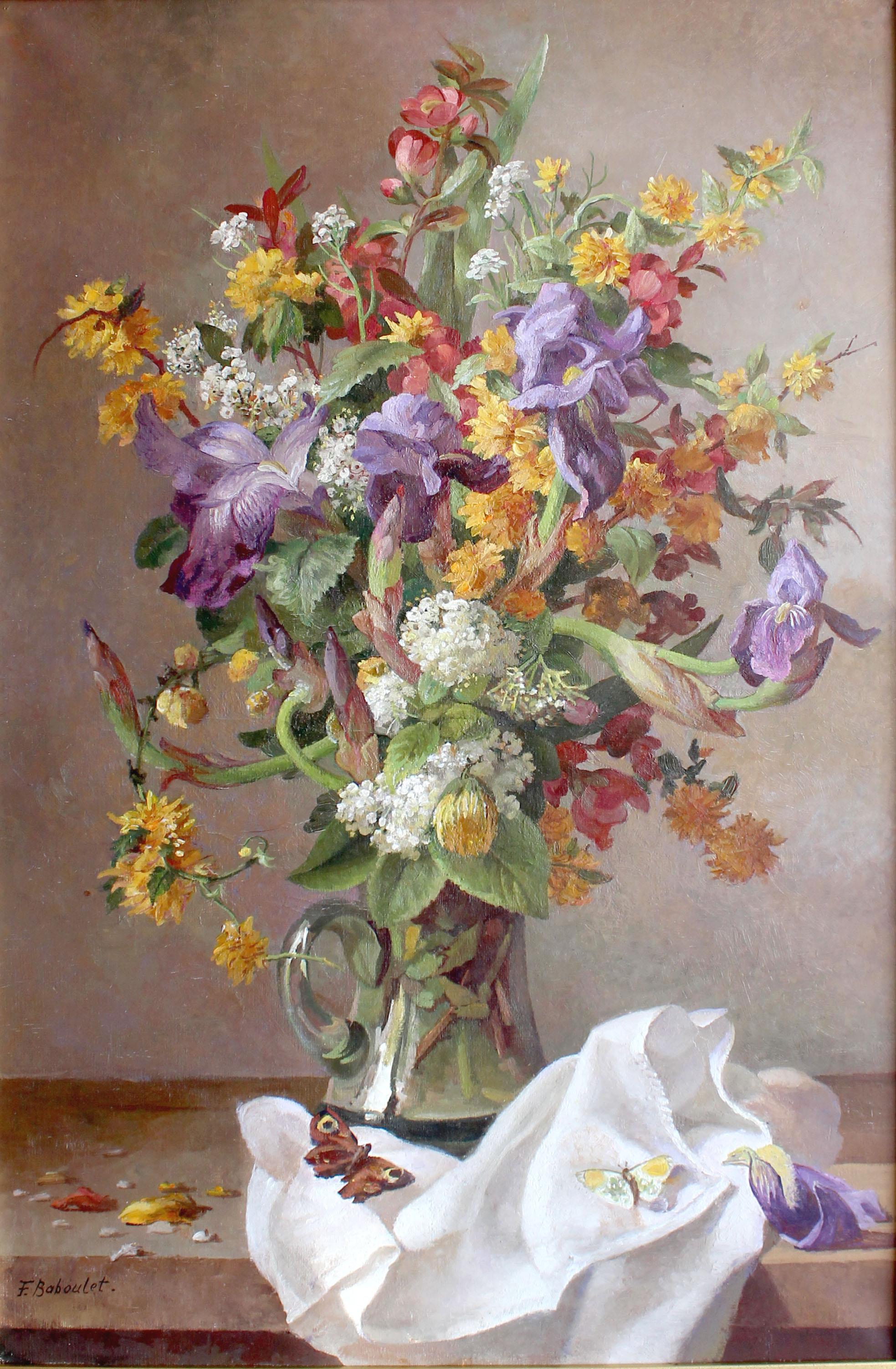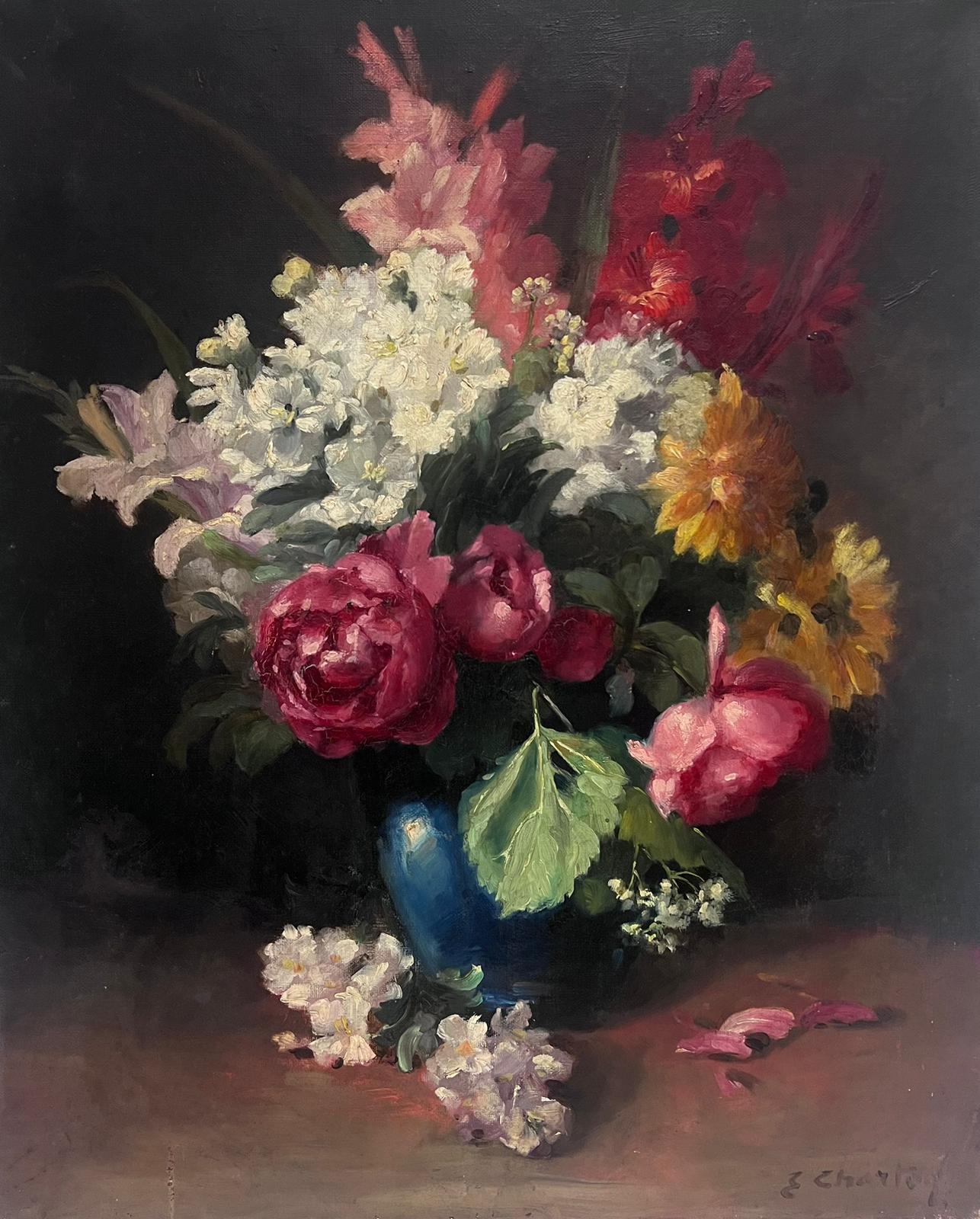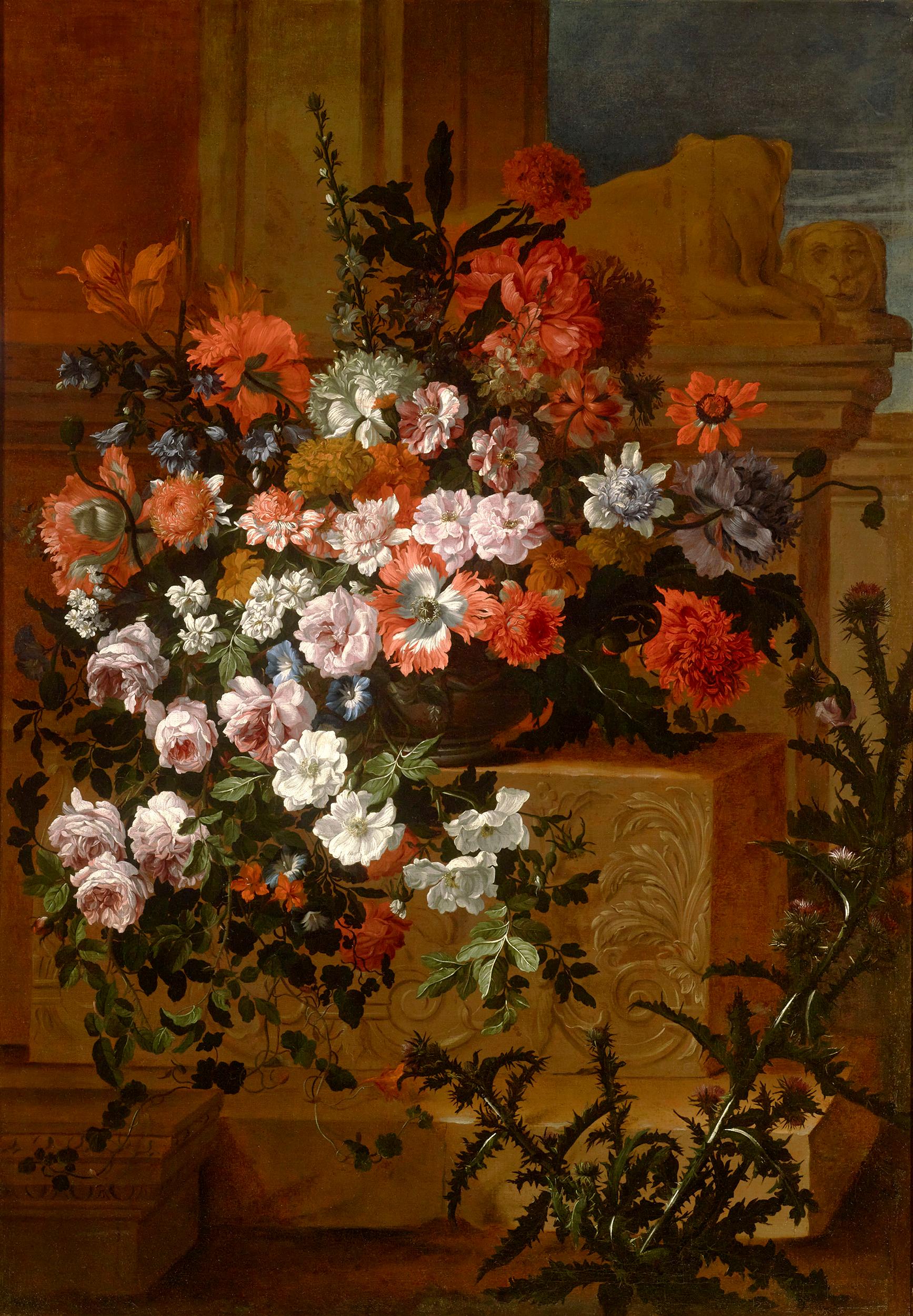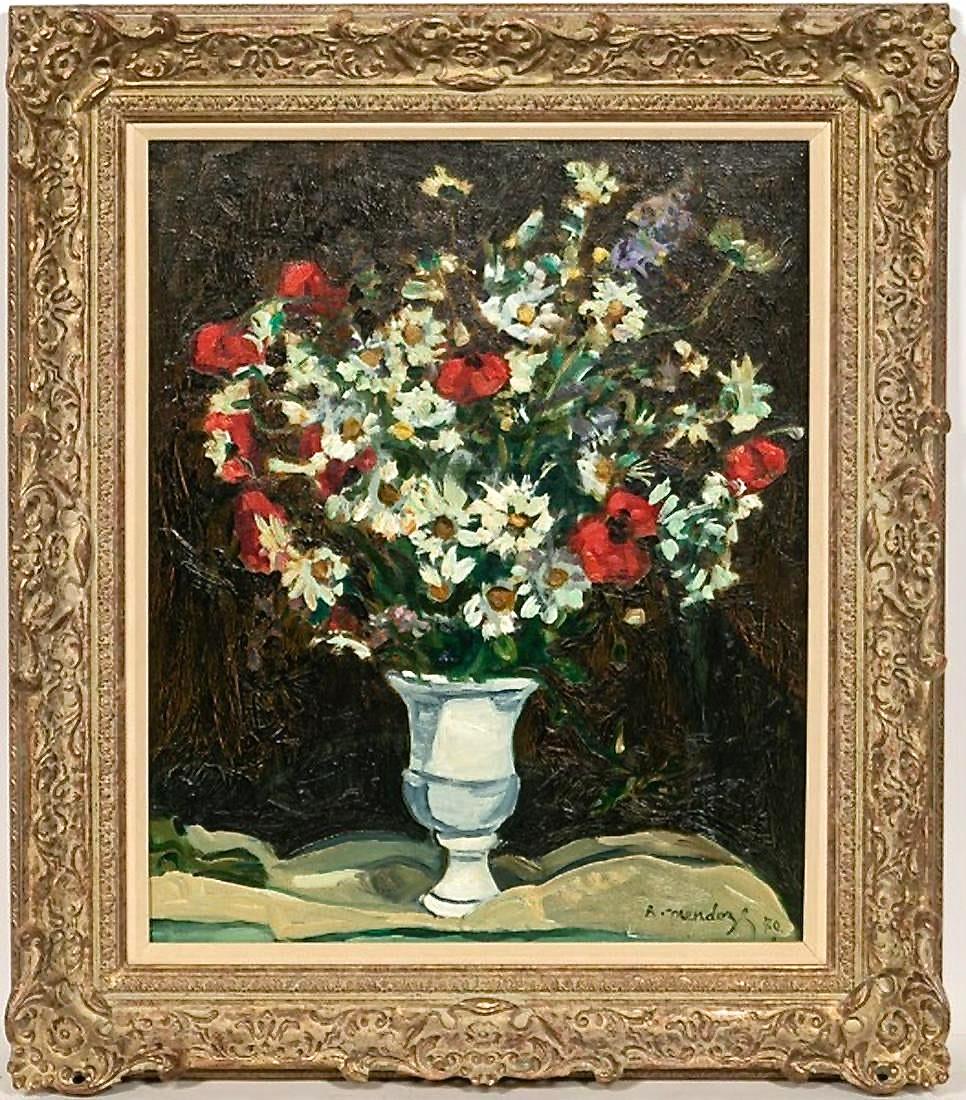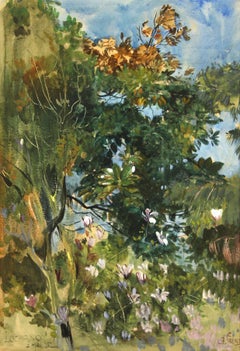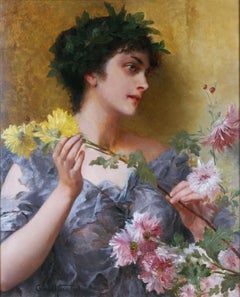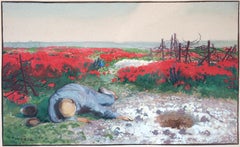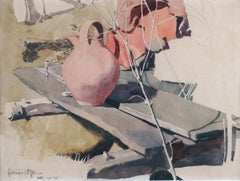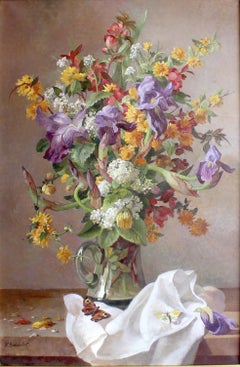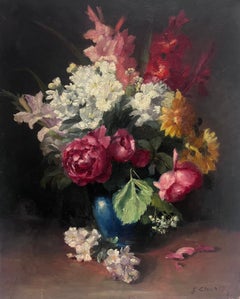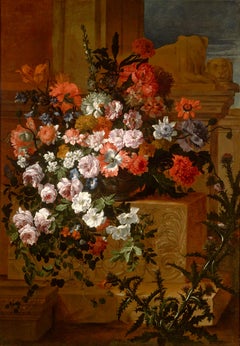Items Similar to Still life with meadow flowers - The beauty of meadow flowers -
Video Loading
Want more images or videos?
Request additional images or videos from the seller
1 of 7
Jean-Baptiste RobieStill life with meadow flowers - The beauty of meadow flowers -about 1900
about 1900
$3,067.25
$3,834.0620% Off
£2,283.37
£2,854.2120% Off
€2,560
€3,20020% Off
CA$4,201.36
CA$5,251.7020% Off
A$4,672.83
A$5,841.0420% Off
CHF 2,440.01
CHF 3,050.0120% Off
MX$56,863.40
MX$71,079.2520% Off
NOK 31,162.62
NOK 38,953.2820% Off
SEK 29,225.04
SEK 36,531.3020% Off
DKK 19,488.39
DKK 24,360.4820% Off
Shipping
Retrieving quote...The 1stDibs Promise:
Authenticity Guarantee,
Money-Back Guarantee,
24-Hour Cancellation
About the Item
Jean-Baptiste Robie (1821 Brussels - 1910 ibid.). Still life with meadow flowers. Oil on wood, 24.5 x 18.5 cm (inside measurement), 37 x 31 cm (frame), signed and dated (difficult to read) 'J. Robie 19[...]' at lower right.
About the artwork
This small-format cabinet painting depicts a bouquet of flowers and thus belongs to the still life genre. However, rather than compete with the opulence of the often sumptuous bouquets in fine painting - which the artist was quite capable of doing, as he illustrated in other works - Jean-Baptiste Robie presents a bouquet of grasses and leaves as it might have been picked during a walk in a flower meadow. In order to emphasise the fact that it is taken directly from nature in front of the house, a large leaf is placed behind the vase, its branches, some of which are already broken, protruding from the other side of the vase.
Because of the large number of leaves and the reduced use of colour, the green within the bouquet seems to be an internal background that merges with the green background. The pink flowers in particular stand out against the green, creating a choreography: As the lower flowers droop, they visibly straighten up towards the top. This illustrates the vitality of the plants. It is now clear that Robie is rethinking the subject of the floral still life: he is no longer interested in highlighting the magnificent beauty of the flowers, but in showing their vitality and thus illustrating the inner life force of nature in which their beauty is based. This vitality enlivens the whole bouquet: the leaves are twisted with inner strength and, like the blossoms, seem to stretch out towards the light.
The contrasting play of light bathes the bouquet in a mysterious chiaroscuro, inspired by studies of nature in the open air. Here, light is translated into colour in an impressionist manner, which is particularly evident in the design of the glass vase: The glass becomes a coloured surface that nevertheless captures the reflection of the window, allowing the stems of the flowers and leaves to shine through.
About the artist
Jean-Baptiste Robie was born in Brussels, the son of a blacksmith. He was initially self-taught until, on the advice of his artist friend Théodore Fourmois, he enrolled at the Royal Academy of Fine Arts and completed his art studies there. From 1843 to 1875, Robie exhibited at the Brussels Salon, as well as the Paris Salon. He achieved further fame through his descriptions of his travels, which took him as far as India.
Thank you for your interest! I hope I have been able to explain to you the special character of the artwork. If you have any questions of any kind, please feel free to contact me.
I wish you many more discoveries in the realm of art,
Dr Martin Kirves
GERMAN VERSION
Jean-Baptiste Robie (1821 Brüsel - 1910 ebd.). Stillleben mit Wiesenblumen. Öl auf Holz, 24,5 x 18,5 cm (Innenmaß), 37 x 31 cm (Rahmen), rechts unten signiert und schwer leserlich datiert „J. Robie 19[…]“.
zum Werk
Das kleinformatige Kabinettbild stellt einen Blumenstrauß dar und reiht sich damit in das Genre des Stilllebens ein. Anstatt jedoch mit der Opulenz der oftmals üppigen in Feinmalerei ausgeführten Blumenbuketts zu wetteifern – was der Künstler, wie er es in anderen Werken veranschaulicht, durchaus vermochte –, präsentiert Jean-Baptiste Robie einen Strauß mit Gräsern und Blättern, wie er soeben beim Spaziergang auf einer Blumenwiese gepflückt worden sein könnte. Um diese Herkunft unmittelbar aus der Natur vor dem Haus zu unterstreichen, ist ein großes Blatt hinter die Vase gelegt, dessen teilweise bereits abgebrochenen Zweige auf der anderen Seite der Vase hervorschauen.
Durch die zahlreichen Blätter und die reduzierte Farbigkeit wirkt das Grün wie ein Binnenfond innerhalb des Straußes, der sich mit dem ebenfalls grüntonalen Hintergrund zusammenschließt. Vor dem Grün heben sich insbesondere die rosafarbenen Blüten ab, die eine Choreographie vollführen: Während die unteren Blüten herabhängen, richten sie sich nach oben hin zusehends auf. Dies veranschaulicht die Lebenskraft der Pflanzen. Nun wird deutlich, dass Robie das Sujet des Blumenstilllebens neu fasst: Es ist ihm nicht mehr daran gelegen, die prachtvolle Schönheit der Blumen herauszustellen, sondern ihre Vitalität aufzuzeigen und damit die innere Lebenskraft der Natur zu veranschaulichen, in der ihre Schönheit gründet. Diese Vitalität belebt den ganzen Strauß: Die Blätter sind vor innerer Spannkraft in sich gewunden und scheinen sich – wie die Blüten – dem Licht entgegenzustrecken.
Das kontrastreiche Spiel des Lichtes versetzt den Strauß in ein geheimnisvolles Hell-Dunkel und beruht auf Freilicht-Studien in der Natur. Dabei wird das Licht in impressionistischer Manier in Farbe übersetzt, was sich insbesondere bei der Gestaltung der Glasvase zeigt: Das Glas wird zur Farbfläche, die dennoch die Spiegelung des Fensters einfängt und die Stiele der Blumen und Blätter durchscheinen lässt.
zum Künstler
Jean-Baptiste Robie wurde in Brüssel als Sohn einen Schmiedes geboren. Zunächst hatte sich autodidaktisch gebildet bis er sich auf Anraten seines Künstlerfreundes Théodore Fourmois in die Königliche Akademie der Schönen Künste einschrieb und dort sein Kunststudium abschloss. Von 1843 bis 1875 stellte Robie im Brüsseler Salon aus, war aber auch im Pariser Salon vertreten. Eine weiter Bekanntheit erreichte er durch die Beschreibungen seine Reisen, die ihn bis nach Indien führten.
Vielen Dank für Ihr Interesse! Ich hoffe, ich habe Ihnen den besonderen Charakter des Kunstwerks näherbringen können. Bei Fragen jeglicher Art können Sie mich gerne kontaktieren.
Ich wünsche Ihnen noch viele Entdeckungen im Reich der Kunst,
Dr. Martin Kirves
- Creator:Jean-Baptiste Robie (1821 - 1910, Belgian)
- Creation Year:about 1900
- Dimensions:Height: 9.65 in (24.5 cm)Width: 7.29 in (18.5 cm)
- Medium:
- Movement & Style:
- Period:
- Condition:
- Gallery Location:Berlin, DE
- Reference Number:1stDibs: LU2438211928072
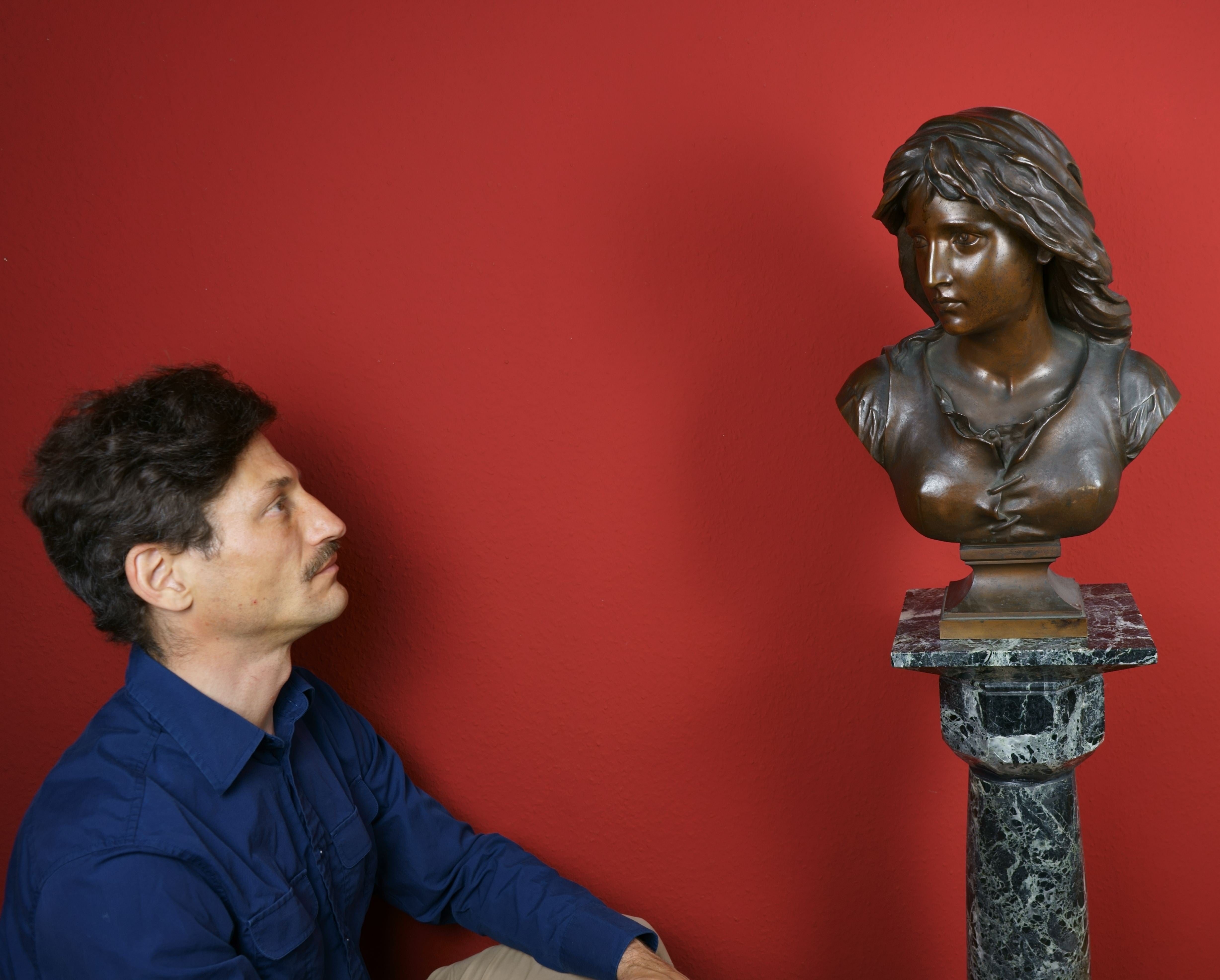
About the Seller
5.0
Gold Seller
Premium sellers maintaining a 4.3+ rating and 24-hour response times
Established in 2014
1stDibs seller since 2023
20 sales on 1stDibs
- ShippingRetrieving quote...Shipping from: Berlin, Germany
- Return Policy
Authenticity Guarantee
In the unlikely event there’s an issue with an item’s authenticity, contact us within 1 year for a full refund. DetailsMoney-Back Guarantee
If your item is not as described, is damaged in transit, or does not arrive, contact us within 7 days for a full refund. Details24-Hour Cancellation
You have a 24-hour grace period in which to reconsider your purchase, with no questions asked.Vetted Professional Sellers
Our world-class sellers must adhere to strict standards for service and quality, maintaining the integrity of our listings.Price-Match Guarantee
If you find that a seller listed the same item for a lower price elsewhere, we’ll match it.Trusted Global Delivery
Our best-in-class carrier network provides specialized shipping options worldwide, including custom delivery.More From This Seller
View AllPlant Impression in Locarno - Floral Crescendo -
Located in Berlin, DE
Alexander Frenz (1861 Rheydt - 1941 Düsseldorf). Plant impression in Locarno. Gouache and watercolour. 35 x 23,5 cm (visible size), 49,5 x 38,5 cm (fra...
Category
1890s Impressionist Landscape Drawings and Watercolors
Materials
Watercolor
$881 Sale Price
20% Off
The gift of flowers / - The depth of allegory -
By Conrad Kiesel
Located in Berlin, DE
Conrad Kiesel (1846-1921), The gift of flowers. Oil on wood, 43 x 35 cm, 69 x 61 cm (frame), signed at lower left "Conrad Kiesel pxt [pinxit]", about 1900. In a magnificent gilt stuc...
Category
1890s Academic Nude Paintings
Materials
Oil
$11,502 Sale Price
20% Off
Red blooming war landscape with dead soldier - Bleeding flowers -
Located in Berlin, DE
Johannes Friedrich Heinrich Hänsch (1875-1945), Red blooming war landscape with dead soldier, 1918. Watercolor and gouache on paper, 15 x 24.5 cm (image), 27 x 37 cm (sheet size / frame), monogrammed and dated "19JH18" at lower left.
- Paper slightly darkened
About the artwork
Despite the relatively small format, the watercolor with an internal frame depicts a panoramic view of a flat landscape stretching to the horizon. As far as the eye can see, the poppies bloom in flaming red. The flowers are not rendered individually, however, creating an almost cohesive red surface. The bright red is interspersed with vegetal green. A complementary contrast that creates an intense color effect. In this color contrast, a white area breaks through from the middle ground, widening towards the foreground and surrounding a brown hole. Next to it, in blue, is the actual protagonist of the painting, the first thing that catches the eye: a dead soldier. Next to him is his helmet, revealing the empty interior. The brown, hollow shape corresponds to the hole in the ground. A shell funnel is surrounded by bright ash, which, like the inverted helmet, becomes a sign of death. The soldier's arms point to the funnel, while the empty helmet paraphrases the calotte of the skull and, like the funnel, thematizes the empty darkness of death.
The soldier's body, however, is intact and not - as in Otto Dix's triptych "The War" - a dismembered corpse. Instead, Johannes Hänsch activates the landscape, especially the color, to illustrate a blooming landscape of death that extends from the shell funnel in the foreground to the rising column of smoke on the horizon. If the soldier's body is intact, the tangle of barbed wire emblematically placed over the empty helmet also appears tattered. On the right side of the picture, the barbed wire even seems to stretch its arms to the sky in horror. Against the background of this allegory, the content of the bright red also becomes clear: the landscape is drenched in blood, literally a sea of blood, and the single unknown soldier stands pars pro toto for all those who died on the battlefield. Dying in war is not dying in community, but in solitude. In order to emphasize the isolation in death, Johannes Hänsch has set the blue of the soldier in the axis given by his body in the middle ground of the picture into the red sea.
A master of landscape painting, Hänsch succeeds in creating a natural-looking landscape allegory that illustrates the horror and death of war, without depicting the brutality of war itself. This singular 'war memorial' of the unknown soldier is the opposite of heroization and yet the dignity of the deceased soldier is preserved through the integrity of his body.
About the artist
As the son of the sculptor Adolf Haensch, the young Johannes received his first artistic training in his father's Berlin studio. However, he eventually decided to become a painter, and in 1897 he entered the Berlin Academy of Arts. He initially studied under Paul Vorgang and Eugen Bracht, and was particularly influenced by Bracht's increasingly colourful landscape painting. In 1901 he moved to the class of Friedrich Kallmorgen, with whom he spent several weeks on excursions into nature. In 1905 he became a master pupil of Albert Hertel, who taught him watercolour painting.
From 1903 to 1933 he exhibited annually at the Great Berlin Art Exhibition, the exhibitions of the Berlin Artists' Association and the Munich Glaspalast. In 1905 he was awarded the Carl Blechen...
Category
1910s Realist Figurative Drawings and Watercolors
Materials
Watercolor
$1,341 Sale Price
20% Off
Clay jug on a bench - The essence of the clay jar revealed by the sunlight -
By Hans Richard von Volkmann
Located in Berlin, DE
Hans Richard von Volkmann (1860 Halle (Saale) - 1927 ibid.), Clay jug on a bench. Pencil and Watercolour on paper. 20 x 26,7 cm (visible size), 37 x 45 cm (frame), dated and monogrammed lower left "Februar 1890 - HR. V. V."
- Minimally tanned. Framed behind glass in a passepartout.
About the artwork
Using the technique of his early youth - pencil and watercolour - Hans Richard von Volkmann depicts a still life. However, this is not a conventional indoor still life, but an open-air depiction, painted outdoors and not in the studio. It is therefore an open-air painting, characteristic of von Volkmann's oeuvre, which could have been painted in the Willingshausen colony of painters, where open-air painting was programmatically practised there and the artist stayed there that year.
And indeed, this painting is a manifesto of open-air painting. Von Volkmann demonstrates that leaving the studio for the light of nature leads to an entirely new quality of art. To prove this, he uses the genre of still life, which can be described as the studio subject par excellence. Moreover, light plays an essential role in the classical still life. It is the real protagonist of the still life. And it is precisely this moment, essential to the still life, that von Volkmann exploits to demonstrate the potential of plein-air painting: He presents the objects as they appear in the sunlight. The date of February and the bare branches in the foreground make it clear that this is a clear winter day in bright sunlight. The delicate plant in the foreground casts a clearly defined shadow, as does the jug. However, the shadow is most pronounced on the jug itself: The underside of the handle appears almost black, making the top, and therefore the jug itself, shine all the more brightly. The shining of the objects in the sunlight is also visible on the bench. As complementary phenomena to the shadow zones, light edges can be seen on the boards of the seats and the upper foot of the bench shines entirely in the light. To achieve this intensity of light, von Volkmann activated the bright white of the painting ground.
By depicting the objects in glistening sunlight, von Volkmann demonstrates that this quality of light is only to be found outdoors. And this light leads to a new way of looking at the objects themselves. The jug on the bench seems like an accidental arrangement, as if the artist had stumbled upon this unintentional still life and captured it with fascination. And in this fascination there is a moment of realisation that refers to the objects themselves. It is only when they shine brightly in the sunlight that their true nature is revealed. In this way, sunlight allows the objects to come into their own, so to speak. Sunlight, which is not present in the studio, gives the still life an entirely new dimension of reality, which is also reflected in the colours interwoven by the sunlight: The bench and the jug stand in a harmonious grey-pink contrast to the green of the implied meadow.
The emphasis on the jug as the central subject of the picture also implies that the watercolour has not been completed. This non finito inscribes a processuality into the picture, making it clear that something processual has been depicted, the temporality of which has been made artistically permanent. This is why von Volkmann signed the painting and dated it to the month.
About the Artist
Von Volkmann made his first artistic attempts at the age of 14. He painted many watercolours of his home town of Halle. This laid the foundation for his later outdoor painting.
In 1880 his autodidactic beginnings were professionalised with his admission to the Düsseldorf Art Academy. There he studied under Hugo Crola, Heinrich Lauenstein, Johann Peter Theodor Janssen and Eduard von Gebhardt until 1888. Von Volkmann then moved to the Karlsruhe Academy, where he was Gustav Schönleber's master pupil until 1892.
In 1883 he came for the first time to Willingshausen, Germany's oldest painters' colony, at the suggestion of his student friend Adolf Lins...
Category
1890s Naturalistic Still-life Drawings and Watercolors
Materials
Watercolor
Autumn Landscape in Sunlight - Indian Summer -
Located in Berlin, DE
Frederick Vezin (1859 Torresdale Philadelphia - 1933 Düsseldorf), Autumn Landscape in the Sunlight, oil on canvas, mounted on cardboard, 32 x 41 cm (inside measurement), 44 x 51 cm (frame), signed and dates lower right "F. Vezin. [19]05".
- Cardboard slightly curved, small inconspicuous retouch at the centre of the upper edge of the picture.
About the artwork
Although the painting appears to be a sketch, Frederick Vezin considered it to be a finished work of art, as evidenced by his signature on the lower right. And it is precisely this sketchy quality that leads to an understanding of the painting, which was certainly created in the landscape itself: the natural phenomena were to be depicted artistically at the moment of their observation. This is not done by meticulously sketching nature, but - and here Vezin follows the teaching of French Impressionism - by illustrating nature in its visual fullness. The artist's eye is, as it were, immersed in the visuality of nature, which is made visible by his hand. The painting is therefore not a reflection of the landscape, but its artistic intensification.
This intensification also includes the fact that the foreground of the painting - corresponding to the field of vision - eludes a detail-oriented close-up view. Instead, the spatula-like application of paint, the vertical structure of which corresponds to the structure of the floral growth, has the effect of making nature tangible in its colourful substance.
At the same time, the foreground, which remains indeterminate in its concrete objectivity, creates an atmospheric space that connects with the actual protagonist of the picture, the group of trees, which flares up in shades of red and brown. Here, too, the leaves are more speckled than clearly outlined. It is precisely this 'sketchiness' that opens up a visual experience that makes the landscape accessible in its visual fullness, thus revealing its essence.
In addition to this abundance, the landscape is presented as a structure of order in that the composition of the picture makes the composition of the landscape visible. For example, the group of trees forms a distinct dark green shadow, which is repeated in the shadows cast by the trees behind it. A patterned diagonal axis is created in the picture, which is composed in this way by the landscape itself.
Strictly speaking, this is a cultivated landscape: a fence at the bottom and a low stone wall at the top, running from left to right, are two elements that also have a strong compositional effect. And on the top of the hill, a stone house is embedded in the landscape as the brightest surface in the picture. Nature and culture here form a harmonious synthesis, giving the painting an Arcadian touch.
In order to give the landscape as much space as possible, the horizon line is raised, but the design of the sky is also crucial. The clouds, combined with the shapes of the trees, create a bright blue sky. To the European eye, such a sky is reminiscent of a summer landscape. Accordingly, within the seasonal cycle, the blue sky is reserved for summer, and French Impressionism is also primarily an ode to summer. In Vezin's painting, however, the brilliant blue sky stands above an autumnal landscape, some of the trees even defoliated. It can therefore be assumed that the painting was made not in Europe but in the United States, and that it illustrates the proverbial Indian summer, making Frederick Vezin a pioneer of American landscape painting.
About the artist
Frederick Vezin was the son of a French immigrant to the United States and a German-born mother. This predestined him to promote artistic exchange between the old and new worlds. Having spent part of his schooling in Germany, in 1876, at the age of 20, he enrolled at the Düsseldorf Academy of Art, where he studied with Peter Janssen the Elder, Eduard von Gebhardt and Wilhelm Sohn, among others. He graduated in 1883, settled in Munich and returned to Düsseldorf in 1895, where he lived until his death in 1933.
A native of the United States, he travelled to the country frequently and became a popular portrait and society painter. His artistic talent, however, was most evident in his landscape paintings. Trained in French Impressionism, he developed a virtuoso use of colour and a free brushwork that remained tied to the landscape motif, opening up the landscape itself in a new way. Frederick Vezin turned his attention primarily to the landscape of his homeland, becoming a pioneer of modern American landscape...
Category
Early 1900s Impressionist Landscape Paintings
Materials
Cardboard, Oil
$2,108 Sale Price
20% Off
Still life with fish bones, pencil and pencil sharpener / - The irony of art -
Located in Berlin, DE
Manfred K. Schwitteck (*1948), Still life with fish bones, pencil and pencil sharpener, 1992. watercolor over pencil on handmade paper, 31.5 x 45 cm (visible size), 47 x 61 cm (frame...
Category
1990s Surrealist Still-life Drawings and Watercolors
Materials
Etching, Watercolor
You May Also Like
Bouquet of flowers with butterflies;
Located in La Canada Flintridge, CA
Baboulet was born on April 12, 1914 in Toulouse and died on the December 17, 2010 in Paris. Throughout his life, he exhibited his art in various galleries and institutions across Fra...
Category
1980s Still-life Paintings
Materials
Oil
Antique French Still Life of Flowers in Vase Signed Oil Painting on Canvas
Located in Cirencester, Gloucestershire
Classical Still Life of Flowers in a Vase
Attributed to Edouard Charton (French, born 1855)
signed oil on canvas, unframed
canvas: 22 x 18 inches
provenance: private collection, Fran...
Category
Early 20th Century French School Still-life Paintings
Materials
Oil
Still Life With Flowers By Jean-Baptiste Monnoyer
By Jean-Baptiste Monnoyer
Located in New Orleans, LA
Jean-Baptiste Monnoyer
1636-1699 French
Still Life with Flowers on a Carved Stone Ledge
Oil on canvas
Impeccable detail and luminous color breathe life into this floral still lif...
Category
17th Century Old Masters Still-life Paintings
Materials
Canvas, Oil
Price Upon Request
Still Life with Flowers
By Eugene Henri Cauchois
Located in Milford, NH
A nicely detailed still life with flowers in a blue vase by French artist Eugene Henri Cauchois (1850-1911). Cauchois was born in Rouen, France, was a student of Duboe, Cabanel and Q...
Category
Late 19th Century Still-life Paintings
Materials
Oil, Canvas
Floral Still Life Country Flowers in a Vase by Flemish Barbizon artist in France
Located in Norwich, GB
A gorgeous floral still life which marries the depth and the richness found in the work of the Flemish old masters with the elegance and light of French painting. As you will see, th...
Category
1880s Flemish School Interior Paintings
Materials
Oil, Panel
Flowers Bouquet Still Life Painting
By Robert Mendoze
Located in Lake Worth Beach, FL
Still Life Bouquet De Fleurs Champs, 1970.
Robert Mendoze was a French Post Impressionist painter who was born in 1930- 2014.
After graduating from the...
Category
1970s Post-Impressionist Still-life Paintings
Materials
Canvas, Oil
More Ways To Browse
Antique Flower Art
Green Cabinet With Flowers
Paintings Of Nuns
Antique Black Plant Stand
Antique Wood India Cabinet
Antique Blacksmith Signs
Sohn Fine Art
Plant Stand Twist
Jean Baptiste Robie
Vegetable Still Life
Mid Century Fruit Still Life
Mid Century Still Life Floral Painting
Oil Paintings With Lemons
Matisse Flowers
Cubist Still Life Art
Fruit With Flowers Oil Painting
Still Life With Tulips
17th Century Dutch Still Life
